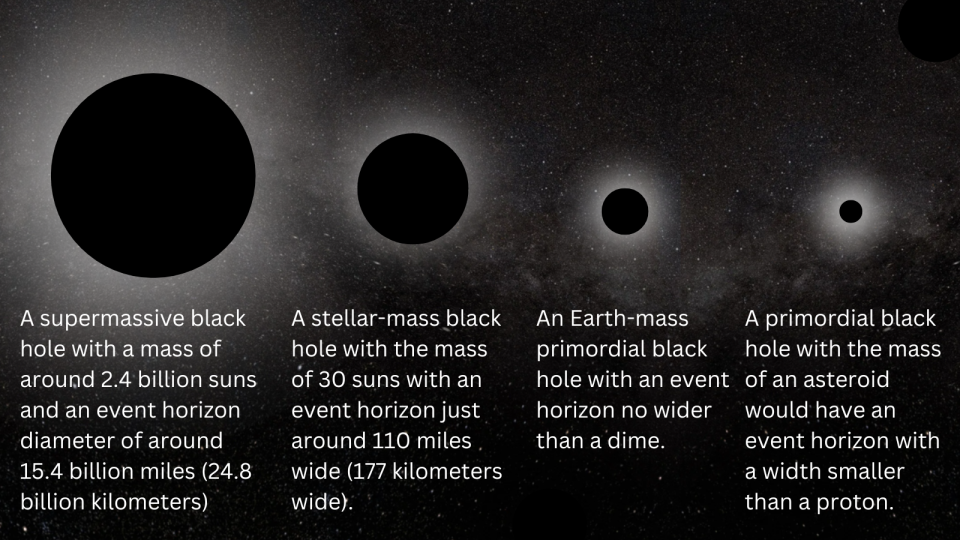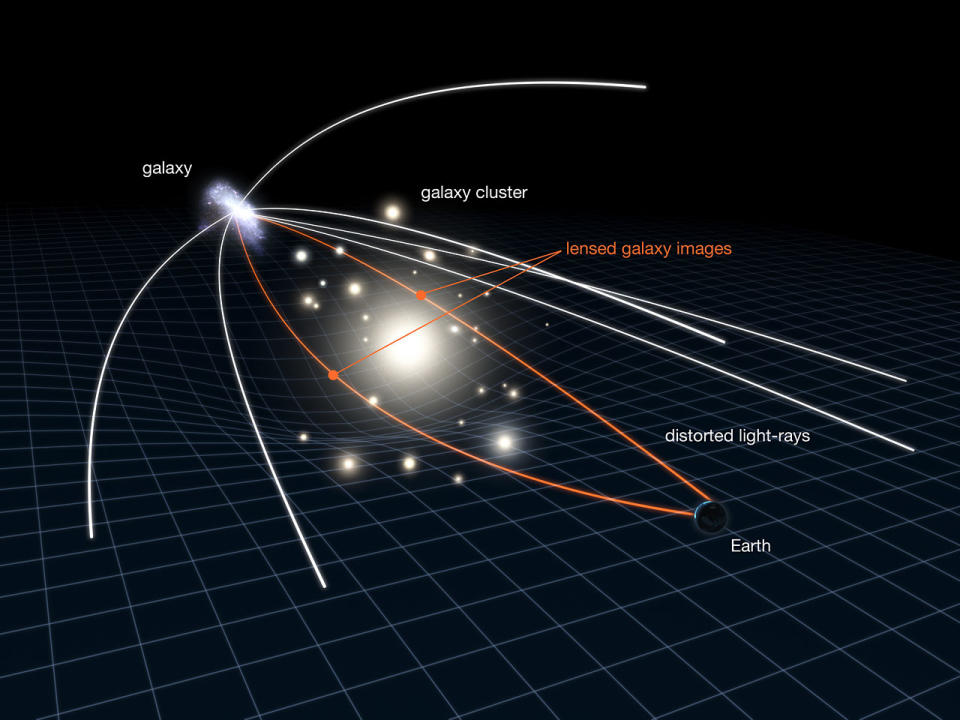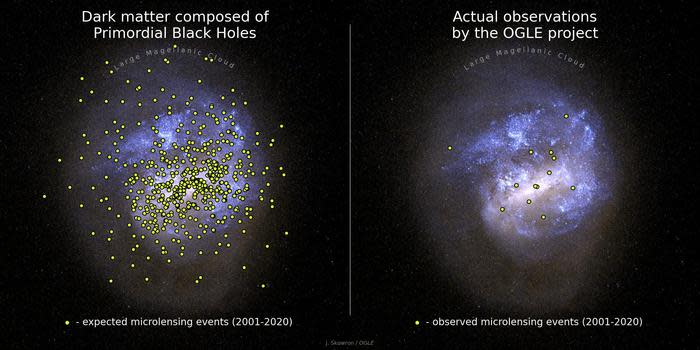Scientists have discovered that the Milky Way’s diffuse outer halo is devoid of any unusually large black holes.
The discovery could spell bad news for theories that suggest dark matter, the universe’s most mysterious “stuff,” is composed of primordial black holes that formed in the early moments after the Big Bang.
Dark matter is confusing because, despite being virtually invisible because it doesn’t interact with light, it makes up about 86% of the matter in the known universe. That means for every gram of “everyday matter” that makes up stars, planets, moons, and humans, there are more than 6 grams of dark matter.
Scientists can infer the existence of dark matter from its interactions with gravity and its effect on everyday matter and light. However, despite this and the ubiquity of dark matter, scientists have no idea what it might be composed of.
Relating to: If the Big Bang created miniature black holes, where are they?
The new dark matter results come from a retrospective review of 20 years of observations conducted by a team of scientists from the Optical Gravitational Lensing Experiment (OGLE) survey at the Astronomical Observatory of the University of Warsaw.
“The nature of dark matter remains a mystery. Most scientists think it consists of unknown fundamental particles,” team leader Przemek Mróz from the Astronomical Observatory of the University of Warsaw said in a statement. said. “Unfortunately, despite decades of efforts, no experiments, including experiments with the Large Hadron Collider, have found new particles that could be responsible for dark matter.”
The new findings not only raise suspicion that black holes are an explanation for dark matter; They also deepen the mystery of why stellar-mass black holes detected beyond the Milky Way appear to be larger than those within the boundaries of our galaxies.
Our primordial black holes are missing!
The team’s hunt for black holes in the Milky Way’s halo owes its origins to the Laser Interferometer Gravitational-Wave Observatory (LIGO) and its sister gravitational-wave detector Virgo, which appear to have uncovered a population of unusually large stellar-mass black holes.
Until the first detection of gravitational waves produced by LIGO and Virgo in 2015, scientists had been finding that the population of stellar-mass black holes born from the gravitational collapse of massive stars in our galaxy tended to have masses between five and 20 times that of the sun.
Gravitational wave observations of mergers between stellar-mass black holes point to a more distant population of black holes with much more mass, equivalent to 20 to 100 suns. “Explaining why these two black hole populations are so different is one of the great mysteries of modern astronomy,” Mróz said.

One possible explanation for this larger population of black holes is that they formed from extremely dense patches of primordial gas and dust, not from the collapse of massive stars, from a period immediately after the Big Bang.
“We know that the early universe was not ideally homogeneous; small density fluctuations gave rise to the current galaxies and galaxy clusters,” Mróz said. “Similar density fluctuations can collapse and form black holes if they exceed the critical density contrast.”
These “primordial black holes” were first postulated by Stephen Hawking more than 50 years ago, but have remained a disappointingly elusive topic. This may be because smaller samples rapidly “leak” a form of thermal energy called Hawking radiation and eventually evaporate; This may mean that they cannot exist in the current period of the 13.8 billion year old universe. However, this obstacle has not stopped some physicists from proposing primordial black holes as a possible explanation for dark matter.
Dark matter is estimated to make up 90% to 95% of the Milky Way’s mass. This means that if dark matter consists of primordial black holes, our galaxy must contain many of these ancient objects. Black holes do not emit light because they are confined to a light-trapping surface called the “event horizon.” This means that we cannot “see” black holes unless they feed on the matter around them and cast their shadows on it. However, like dark matter, black holes also interact with gravity.
Mróz and his colleagues were thus able to invoke Albert Einstein’s 1915 theory of gravity, general relativity and a principle he put forward to hunt for primordial black holes in the Milky Way.
Einstein helps
Einstein’s theory of general relativity states that objects with mass bend the fabric of space and time, which are combined into a single entity called “spacetime.” Gravity is a result of this curvature, and the more massive an object is, the more extreme the bending of spacetime and therefore the greater the “gravity” it produces.
This curvature not only tells planets how to orbit stars and stars how to race around the centers of their own galaxies, but it also bends the path of light from background stars and galaxies. The closer the light is to a massive object, the more its path is “bent.”
The different light paths from a single background object can thus be bent and the apparent position of the background object shifted. Sometimes, the effect can even cause the background object to appear in more than one place in the same image of the sky. Other times, the light from the background object is amplified, making that object appear larger. This phenomenon is called “gravitational lensing”, and the intervening body is called a gravitational lens. Weaker examples of this effect are called “microlenses”.


If a primordial black hole in the Milky Way passed between Earth and a background star, we should see microlensing effects on that star for a short time.
“Microlens formation occurs when three objects—an observer on Earth, a light source, and a lens—are nearly ideally aligned in space,” said Andrzej Udalski, Principal Investigator of the OGLE study. “During microlens formation, the light of the source can be deflected and magnified, and we observe a temporary brightness in the light of the source.”
How long the light from the background source remains bright depends on the mass of the lensing body passing between it and the Earth; more massive objects create longer microlensing events. An object around the mass of the Sun should cause a brightening for about a week, but for lensing bodies with a mass of 100 times the mass of the Sun, the brightening should last for up to several years.
There have been previous attempts to use microlensing to detect primordial black holes and study dark matter. Previous experiments suggested that black holes have a mass less than the Sun and may contain less than 10% of dark matter. However, the problem with these experiments was that they were not sensitive to microlensing events on extremely long timescales.
Therefore, these experiments were not sensitive to this black hole population either, as more massive black holes (like those recently detected by gravitational wave detectors) would produce longer events.


This team turned to 20 years of monitoring of about 80 million stars in a satellite galaxy, or Milky Way, called the Large Magellanic Cloud (LMC), increasing sensitivity to long-duration microlensing events.
The data examined, described by Udalski as “the longest, largest and most accurate photometric observations of stars in the LMC in the history of modern astronomy,” were collected by the OGLE project in its third and fourth phases from 2001 to 2020. The team compared the microlensing events seen by OGLE with the theoretically predicted amount of such events, assuming that the Milky Way’s dark matter consists of primordial black holes.
“If all the dark matter in the Milky Way consists of 10 solar-mass black holes, we should have detected 258 microlens events,” Mróz said. “For a 100 solar-mass black hole, we expected 99 microlens events. For a 1,000 solar-mass black hole — 27 microlens events.”
In contrast to these estimated event amounts, the team found only 12 microlensing events in the OGLE data. Further analysis revealed that all of these events could be explained by known stars in the Milky Way and the LMC itself. After these calculations, the team found that black holes with a mass of 10 solar masses could contain at most 1.2% of dark matter, smaller black holes with a mass of 100 solar masses could contain at most 3.0% of dark matter, and black holes with a mass of 1000 solar masses could contain only 11% of dark matter.
“This suggests that massive black holes may constitute at most a few percent of dark matter,” Mróz said. he explained.
RELATED STORIES
— Dark matter detected hanging from the cosmic web for the first time
— How will the Large Hadron Collider’s successor hunt for the dark universe?
— ‘Supercharged rhino’ black holes may have formed and died a second after the Big Bang
“Our observations suggest that primordial black holes cannot constitute a significant fraction of dark matter and also cannot explain the observed black hole merger rates measured by LIGO and Virgo,” Udalski said. “Our results will remain in astronomy textbooks for decades to come.”
This has astronomers going back to the drawing board to explain the supermassive stellar-mass black holes observed beyond the Milky Way, while physicists continue to ponder the true nature of dark matter.
The team’s research was published June 24 in Nature and the Astrophysical Journal Supplement Series.